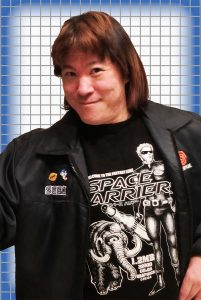 Having a career in the video game industry is a dream job for many people, but few get to actually make it come true. Chris Tang was one of the luckiest, having entered gaming at an early age. He won the Hawaii State Nintendo Championships and was Los Angeles City Champion in the 1990 Nintendo World Championships, and topped that by winning Sega’s famous Sonic & Knuckles “Rock the Rock” tournament on Alcatraz in 1994. From there, he went on to have a career that continues to this day. He worked at Tengen and had a hand in several classics like Gauntlet IV (where he was instrumental in the inclusion of its Quest Mode) and Rampart, as well as at Capcom during its Dreamcast glory days.
Having a career in the video game industry is a dream job for many people, but few get to actually make it come true. Chris Tang was one of the luckiest, having entered gaming at an early age. He won the Hawaii State Nintendo Championships and was Los Angeles City Champion in the 1990 Nintendo World Championships, and topped that by winning Sega’s famous Sonic & Knuckles “Rock the Rock” tournament on Alcatraz in 1994. From there, he went on to have a career that continues to this day. He worked at Tengen and had a hand in several classics like Gauntlet IV (where he was instrumental in the inclusion of its Quest Mode) and Rampart, as well as at Capcom during its Dreamcast glory days.
Today, Chris is an eSports commentator known as the voice behind the Classic Tetris World Championships’ “BOOM! Tetris for Jeff!” meme, has been a recurring speaker at the Game Developers Conference, and continues his work as a game creator. While Chris has been involved with releases for retro consoles such as the Genesis, TurboGrafx-16 and Dreamcast, he focuses his primary development efforts to create modern games that breathe new life into loved but underrepresented genres built on an expertise and love for classic Sega games in particular.
We recently got the chance to speak with Mr. Tang about his competitive experiences, his time at Tengen and Capcom, and his current endeavors.
Sega-16: You won the Sonic & Knuckles “Rock the Rock” competition on Alcatraz. How did you prepare for such an event? Was it something you began to work on after you decided to enter the competition?
Chris Tang: The “Rock the Rock” competition happened prior to the Sonic & Knuckles game release so I had to practice on Sonic 3, and I knew some things like the ‘Collect Spheres” scenes were common between both games so I played that a lot. Once I got to the competition, I found out the sphere segments played no part at all in what we needed to compete on, so I had to adjust on-the-fly and learn the level layout for Mushroom Hill Zone to make the most of it on the day of the qualifier at Hard Rock Cafe. Having solid fundamentals from playing Sonic 3 certainly helped, however, and going into the grand finals on Alcatraz – where it was on Sonic 3’s Launch Base Zone using Knuckles – practicing on Sonic 3 the night before made a huge difference! My brother Michael had won the HoJo National Championships on Sonic 3 and was able to give me some good advice along the way, as we always helped each other do our best on various competitions. The Sega competition wasn’t my first, as I was a Los Angeles City Champion in the 1990 Nintendo World Championships and won the Hawaii State Nintendo Championships among other events. A funny side note to that is when I was interviewed for the Nintendo competitions and asked what my favorite game was, my answer was always Phantasy Star, which of course is a Sega game!
Having experience in those other competitions made me a lot more prepared and mentally focused for the Sega event, which I could tell was going to be something historic and special. For the big console-sponsored eSports competitions of the ‘90s, being adaptable to the dynamic rulesets and unpredictable conditions of those events is something people nowadays may not easily realize or understand. Back in those days, you couldn’t practice for months or years and tools like emulation and YouTube videos simply didn’t exist; you were on your own to find the best path to victory and had very little time to prepare. The slightest mistake in timing would end it all. In Sonic, getting hit meant losing all your rings and instant defeat, so you had to play without making any mistakes and still push your limits to outscore everyone else. I would even “hide my power level” and hold back my optimal patterns, scoring only what was necessary so that other competitors couldn’t learn from me in real-time… that’s how serious I had to be! Every play was your one shot to advance, and if you failed there was no “maybe next year,” especially in the cases of the Nintendo and Sega World Championships, as they were once-in-a-lifetime experiences.
Sega-16: It must have been a whirlwind experience, with Bill Bellamy and Daisy Fuentes from MTV there and all the cameras.
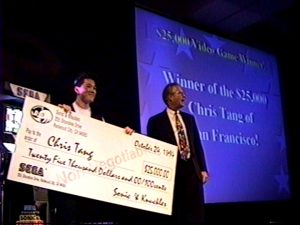 Chris Tang: Absolutely. The media presence and sheer spectacle was on a totally different level than anything I had, or probably ever will ever behold in gaming. You don’t often get to see a gaming event taking over an island, let alone a national historic landmark like Alcatraz, but Sega put millions of dollars into the restoration of the island to make the event possible, and that was symbolic of their strength and their desire to contribute to the local economy. Having the celebrities and the cameras and production crew definitely added to the chaos and energy of the event. It was very much going to be a show for the media, TV viewers, and Sega and Sonic fans as much as it was a competition with high stakes, so I was glad I could maintain the right presence of mind to deal with that and still stay focused on performing. Sega was at the very height of their market dominance in 1994, and the “Rock the Rock” Championships was the epitome of that success, so I’m really glad I got to play a part in that moment in history. To be honest I didn’t care about Bill and Daisy and was more hyped that I got to meet Yuji Naka and that that Tom Kalinske himself handed me a giant check for $25,000 at Sega Headquarters!
Chris Tang: Absolutely. The media presence and sheer spectacle was on a totally different level than anything I had, or probably ever will ever behold in gaming. You don’t often get to see a gaming event taking over an island, let alone a national historic landmark like Alcatraz, but Sega put millions of dollars into the restoration of the island to make the event possible, and that was symbolic of their strength and their desire to contribute to the local economy. Having the celebrities and the cameras and production crew definitely added to the chaos and energy of the event. It was very much going to be a show for the media, TV viewers, and Sega and Sonic fans as much as it was a competition with high stakes, so I was glad I could maintain the right presence of mind to deal with that and still stay focused on performing. Sega was at the very height of their market dominance in 1994, and the “Rock the Rock” Championships was the epitome of that success, so I’m really glad I got to play a part in that moment in history. To be honest I didn’t care about Bill and Daisy and was more hyped that I got to meet Yuji Naka and that that Tom Kalinske himself handed me a giant check for $25,000 at Sega Headquarters!
Sega-16: What happened after the competition? Did it help you get into the video game industry in any way?
Chris Tang: By that time, I had already been “in” the industry for awhile, having started at Tengen when I was still a kid after being discovered at the Nintendo World Championships. In that era there were a few hardcore “Professional Gamer” types that I was among who worked at game companies, wrote for game magazines, and were active competitors; and we’d usually see each other at trade shows like the Consumer Electronics Show (CES), Electronic Entertainment Expo (E3), and the Amusement & Music Operators Association Expo (AMOA). There were people at Sega who knew I had a pretty good shot at winning the whole thing, as some of them knew me from trade shows and freelance press. In those days, you couldn’t love video games as much as I did and not want to be involved in them in EVERY way possible! So, while this competition wasn’t the catalyst that got me into the business, it was interesting going into the office the next week and saw that my Tengen department heads had found out I had won the big contest since it was on the paid corporate news wire, and someone had put a printout of it on my desk!
Speaking of the “after”… I do really miss this era of exciting large scale competitions. As gaming caught on to the mainstream, console companies stopped seeing a need to run large events like this. However, the spirit of these contests where anyone of any age can play at a regional competition and win a trip to a world championships is something that I’m happy that the Classic Tetris World Championship that I’m currently involved with as a consultant and commentator is doing well to carry on the tradition of in the present day, even if at a much smaller scale. Sega was a primary sponsor of ours in 2017, and last year Tetsuya Mizuguchi was with us to show off Tetris Effect before its release at last year’s finals!
Sega-16: How did you start at Tengen?
Chris Tang: I was “discovered” at the Nintendo World Championships by a lifelong friend and fellow International Video Game Hall of Fame inductee Mike Klug, who was a champion on games like Pole Position and RBI Baseball. We had both traveled down to Los Angeles from Northern California to try and win the City Championship and ended up hanging out. I actually had no idea he worked for a game company until the end of the event, after I had won it and he handed me a Tengen business card and I totally started flipping out, as I was a huge fan of their games and even knew about the complicated legal politics between them and Nintendo. I started going into their offices in Milpitas, California, a couple of weeks later. I did many odd jobs in the consumer product development department like writing bug reports, answering game counseling calls (my childhood dream job!), advising on games being evaluated for publishing, writing manuals, and helping with game development in general. This was an excellent trial-by-fire way to become a game designer since I got to see so many aspects of the business up close and personal.
I think a major turning point for me was when we got a version of Rampart for the Sega Genesis, and it started off as a disaster. The maps were all wrong, the gameplay was busted and it upset me since I loved the arcade game. I took it upon myself to go to the coin-op side of the building, researched and sourced the level maps from the arcade version, and then provided materials and worked with the programmer to remake the maps and game play to be much closer to that of the arcade version. I think the people in my department saw my enthusiasm, so they encouraged me and let me do a lot more than would normally have been allowed! Genesis Rampart was the first game I was credited in, and it was kind of a big deal for me, especially at that age.
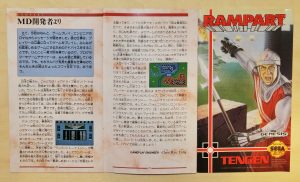 In Japan, Tengen games were special because their manuals featured an extensive extra section that included developer interviews, bios, fan letters, and a Q&A section. At some point after the project, Bill Hindorff, our head of product development came to me and said that Rampart was being released in Japan. While usually the programmer gets a bio in the manual, they didn’t like him and wanted me to get my bio in the manual instead! So, there’s this bio/interview of me in the Mega Drive Rampart manual, in Japanese, that represents one of my most treasured memories of my early years in the business.
In Japan, Tengen games were special because their manuals featured an extensive extra section that included developer interviews, bios, fan letters, and a Q&A section. At some point after the project, Bill Hindorff, our head of product development came to me and said that Rampart was being released in Japan. While usually the programmer gets a bio in the manual, they didn’t like him and wanted me to get my bio in the manual instead! So, there’s this bio/interview of me in the Mega Drive Rampart manual, in Japanese, that represents one of my most treasured memories of my early years in the business.
Sega-16: While at Tengen, you worked on a bunch of great Genesis titles, including Gauntlet IV, developed by the talented group at M2 (3DS Sega Ages). Originally, the game wasn’t going to include the quest mode, and you had a major role in its inclusion, correct? How did the new mode come about?
Chris Tang: At Tengen, we received a pretty wide range of products that would be considered for publishing, and management wanted to put the best stuff out that we could, so my reports and feedback on those things were a key influence on our product line. When we got a version of Gauntlet for the Genesis/Mega Drive in the summer of 1992, the only thing I knew about it was that it came from Tengen Japan. I didn’t know who developed it specifically, but I was excited to get whatever came out of the Japan office, since previous works such as Klax on the TurboGrafx were accurate and of high quality. The version of Gauntlet we received appeared to be a straight port of the 1985 arcade game, which was impressive on the surface but hadn’t exactly aged well in the context of 1992/1993 due to evolving expectations for home games. Even the 1987 NES Gauntlet had added modern game features like password saves, a linear quest, a final boss, and an ending which the arcade version lacked. As it stood, a straight port wasn’t something I felt we could sell as a full-priced Genesis console game in that era.
What we got from the developers was interesting because it felt like a precise arcade conversion in a different engine or environment. I was very familiar with Atari’s arcade hardware and software and seeing certain things, like how the menus were implemented on the console prototype, clearly existed outside of Atari’s less-sophisticated underlying systems of 1985, but the graphics and UI were very accurate. I think my inner gamer instinct took this as a clue as to what might be possible. My imagination ran wild thinking of what I would want in a re-created Gauntlet game engine. I wrote a proposal to give it a full-fledged action/RPG mode similar to Dungeon Explorer for the TurboGrafx/PC Engine by doing things like turning score into experience points with upgradable stats, adding shops for equipment and items, and giving the game a storyline with elemental worlds, bosses, and multiple endings. I believed that these were the features that were needed for the game to best fit the expectations of the time. I was a huge fan of Gauntlet when it ruled the arcades and had since become obsessed with newer quest and story-oriented RPGs like Phantasy Star and Ys I-II and really wanted to see Gauntlet evolve into something more.
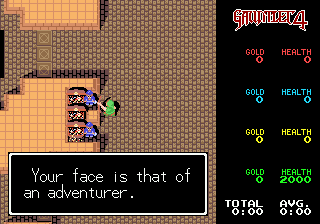 Looking back on my proposal, it seems almost unreasonable to ask that much work of a developer, but I was just crazy and excited enough at the possibility to try and shoot for the moon even if it was unlikely that anything would come from it. So, the proposal was sent off, and I’m not even sure if our official stance translated into Japanese as a polite request or an outright mandate saying we wouldn’t release the game without these features! But a few months later, we got a new version of the game in and to my shock and awe, on the menu there was now a “QUEST MODE” with the vast majority of my requests implemented, though to a smaller scale. It was well-executed and clever, doing things like turning the thief graphic into a shopkeeper and up-pitching the game’s iconic “WELCOME” voice to sound like a dwarf was saying it, earned my respect as well as gratitude. Elementally-themed environments, new effect tiles, EXP level-up system, bosses, multiple endings, and password save system – were all in there from my proposal. The only thing I asked for that didn’t get put in were additional character classes but the bigger picture of what was done was such a monumental and significant achievement that we re-branded the game into Gauntlet IV with the “Episode IV: The Castle of Succession” Quest Mode as its standout feature – and it exists as one of Tengen’s very best, critically-acclaimed releases.
Looking back on my proposal, it seems almost unreasonable to ask that much work of a developer, but I was just crazy and excited enough at the possibility to try and shoot for the moon even if it was unlikely that anything would come from it. So, the proposal was sent off, and I’m not even sure if our official stance translated into Japanese as a polite request or an outright mandate saying we wouldn’t release the game without these features! But a few months later, we got a new version of the game in and to my shock and awe, on the menu there was now a “QUEST MODE” with the vast majority of my requests implemented, though to a smaller scale. It was well-executed and clever, doing things like turning the thief graphic into a shopkeeper and up-pitching the game’s iconic “WELCOME” voice to sound like a dwarf was saying it, earned my respect as well as gratitude. Elementally-themed environments, new effect tiles, EXP level-up system, bosses, multiple endings, and password save system – were all in there from my proposal. The only thing I asked for that didn’t get put in were additional character classes but the bigger picture of what was done was such a monumental and significant achievement that we re-branded the game into Gauntlet IV with the “Episode IV: The Castle of Succession” Quest Mode as its standout feature – and it exists as one of Tengen’s very best, critically-acclaimed releases.
I didn’t find out M2 was responsible for it until years later. I didn’t know that the MD Gauntlet had been built unsolicited and had taken a path from their ‘garage’ to the Tengen Japan office, which then went to my department heads at Tengen USA who had the legal rights for it, then fatefully ended up on my desk. By the time I learned it was M2, I had already been enjoying the fruits of their efforts like Space Harrier on the 3DS, where they did things like adding the extra boss “Haya Oh” to the arcade game engine, which I felt was a pinnacle of game of development triumphs for one of my favorite games of all time. Feeling the connection between their very first project where something “very extra” was added in form of Gauntlet IV’s Quest Mode to their current reputation where they’re THE developer known for adding amazing things to make games better… it gave me a butterfly-effect level of my mind being blown, realizing that writing that proposal all those years ago may have been one of the seeds to start this legacy of “doing more” that extended into the future and affected the games I would play and love. So, I’m very thankful I was able to play that kind of role in their first project!
Sega-16: Robo Aleste, the sequel to the MSX and Master System Power Strike games and the Genesis classic M.U.S.H.A., was the only Tengen-branded release for the Sega CD. Do you know why Tengen didn’t support the add-on more?
Chris Tang: The easy answer is that games on that platform in general weren’t exactly hot sellers but knowing our publishing situation, the reasons become even more clear with the contrast to cartridge games as part of the company’s business. Something that isn’t widely known is that Tengen, since we were a division of Atari Games which made arcade machines, had a cartridge/PCB factory and assembly facility on-site. This gave us tremendous manufacturing and publishing power, and many games produced and released by Sega themselves (including Sonic 2 which I got to play a few weeks early as a result!) were actually manufactured by our facility at Tengen. Building carts used resources we already had at a market advantage, while having to publish on CD didn’t give us any of those advantages. I think Robo Aleste was a way to test the waters to see if it would be worth developing or publishing additional games on CD; we put in the marketing effort with full-page magazine ads, and the game itself was easily one of the best on the platform, but it was pretty clear that the format wasn’t catching on and that cartridges were going to be the way to go for Tengen.
I was a huge proponent for us to publish Robo Aleste and pushed hard with everyone in the department to make it happen since I was an obsessive fan of Compile and loved Power Strike and Golvellius on the Master System, Zanac on the NES, and Seirei Senshi Spriggan on the PC Engine. Looking back at my old reports almost feels like I was writing fan letters to Compile, hoping that one of their staff would get to read it or something, it’s kind of embarrassing! At one point we were going to call the game NINJA ALESTE, but Sega Europe picked up the game and named it Robo Aleste for that region so we ended up sticking to that for our release, too. Unlike Gauntlet IV, my requests for additional features like timed contest modes and power-up voices were not granted, but I’m still happy we got to publish it.
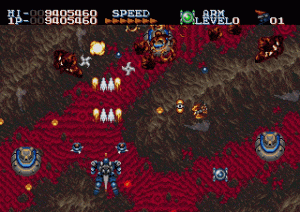 Robo Aleste is the only Sega CD game with Tengen branding, but what happened around that time is the office changed its name from Tengen to Time Warner Interactive due to some changes in the parent company organization. Most of us there still considered it to be Tengen and nothing else was really different, but that makes it so that there were a few more Sega CD games that we published. I wasn’t involved much, since I had switched to working on Primal Rage on the coin-op side of the building around that time as well.
Robo Aleste is the only Sega CD game with Tengen branding, but what happened around that time is the office changed its name from Tengen to Time Warner Interactive due to some changes in the parent company organization. Most of us there still considered it to be Tengen and nothing else was really different, but that makes it so that there were a few more Sega CD games that we published. I wasn’t involved much, since I had switched to working on Primal Rage on the coin-op side of the building around that time as well.
Sega-16: You eventually moved over to Capcom, where you were involved with the Dreamcast classics Cannon Spike and Resident Evil: Code Veronica. What was your role in their development, exactly?
Chris Tang: Going from Tengen to Atari, I became a full-time game designer on Primal Rage, which did really well, and then went on to Primal Rage II, which was canceled. When they were disbanding the Primal Rage II team, I had the job lined up at Capcom Japan. My role at Capcom was less hands-on than it was at Atari Games, since development took place in Japan and while I was working directly for Capcom Japan, it wasn’t the same as designing attack animations, writing game stories, and editing timings and collision boxes on a day-to-day basis. I had just come off of working on the fighting games Primal Rage and Primal Rage II and would be going on to games like Street Fighter III in a capacity that was closer to my work at Tengen: writing reports, analyzing competitor’s games, designing features and gameplay systems, coming up with proposals for new games to develop, and localization work for everything that came out in that era. For the Dreamcast titles, I did a lot of localization writing, and I got to title some of the games. For instance, I came up with the Tech Romancer title, even though it wasn’t my first choice. I actually wanted it to be called Machine King!
Sega-16: Capcom was a strong supporter of the Dreamcast and released a ton of great fighting games like the Power Stone games. What was the attitude at the company regarding the system and the looming launch of the PlayStation 2? Was there ever talk of abandoning the Dreamcast and bringing exclusives like Cannon Spike and Power Stone over to Sony’s console?
Chris Tang: While I can’t speak for management’s stance on those things, I can comment on what I observed. Capcom was very good at building around a target development environment and iterating its tools and games to make the most refined products possible on it. You could see that trend from its very first games, eventually maturing with the CPSII arcade hardware to the point where it was practically its own platform with third party developers like Cave, Takumi, and Mitchell. When CPSIII didn’t pan out, Capcom needed a strong development pillar which would be a real successor to the CPSII in terms of its tool chain and style of development, and it became clear that the Naomi/Dreamcast would become that next step. Arcade conversions were seamless, and Capcom’s games in general all ran very well and polished under that environment. Since Capcom at the time had such a strong arcade core, Naomi/Dreamcast worked well for that business model. Unless there was an equally strong PlayStation 2-based arcade standard, it would never give Capcom the kind of synergy that Naomi and Dreamcast did, so “abandoning” it wasn’t really a thing to be considered. By the time PlayStation 2 hit its stride, arcade games were already on their way out, so Capcom just made console-specific games afterward. Missing that attachment to solid arcade hardware in the following era, I do feel as though something may have been lost in the Capcom design “language” and tools solidarity that had been so strong in years past.
Sega-16: You were recently involved with an indie game called FX Unit Yuki that was released for the PC-Engine, Genesis, and Dreamcast. How did that come about?
Chris Tang: I’ve been a guest at various conventions for some years now and attended the excellent Game-On Expo in Phoenix, AZ, where I was doing some early showings for Strike Blazinger, among other things. There was a new game being released for the PC Engine/TurboGrafx called Henshin Engine that I had seen mentioned in passing, but it was being shown for the first time at that convention. Sarumaru, the creator of that title, noticed our game being demoed and saw a striking similarity between the character designs of our projects, since they both have this ‘90s sci-fi/anime vibe that’s rarely seen now, and we became good friends. After the show, a well-known YouTuber, Johnny Millennium (The Happy Console Gamer) covered both of our games in-depth, in the same video, completely unprompted and from having interacted with us separately, which we thought was a hilarious coincidence. At some point we started talking about having our main characters cameo in each other’s game because they’re so aesthetically compatible, so that’s what ended up happening, though Henshin Engine became renamed to FX-Unit Yuki and shipped much earlier than our game.
FX Unit Yuki is a fun and solid action/platformer with some cute references to the 16-bit console wars, with NEC and Sega in particular having humanized character representations along the lines of Sega Hard Girls. While the main character Yuki attacks with a sword and has a special shot attack, the secret character, Valiya from Strike Blazinger, has a primary shot attack with a special sword attack, so our designs inherently fit very well together. For the cameo, I did the writing for Valiya’s story campaign which called upon some of the skills from my work at Capcom where I would rewrite dialogue into “idea chunks” that would flow well and fit into character-limited spaces and not have awkward dashes and sentence breaks. It’s something that’s not thought of or done too often in modern games since limited screen space isn’t such an issue anymore, but I think that condensing ideas effectively is a great writing skill to practice in any situation. I was happy I got to be involved on this project, as the PC Engine is my favorite console ever (partly because it had some of the best versions of Sega games), but I never got to work on any games for it during its era, so this indie release helped that dream come true retroactively.
Sega-16: Is the game still available for purchase?
Chris Tang: Yes. For the PC Engine/TurboGrafx Super CD and Dreamcast versions, go to the FX Unit Yuki website, and for the Mega Drive/Genesis version, or if you are in Europe and want the Dreamcast version with lower cost shipping, visit PixelHeart! A Windows PC version should also be coming soon!
Sega-16: Strike Blazinger is another new title you’ve worked on, and it looks like a wonderful evolution of the Space Harrier series. Tell us about the project and when it will be available.
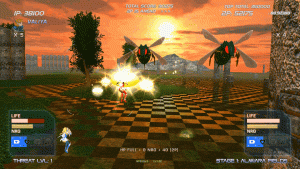 Chris Tang: Strike Blazinger is my current project, which aims to evolve the rail shooter genre into something new and unique while capturing the special rush and thrill that only the best-executed games can provide. Blow stuff up at high speeds and survive with style! While the game can be played well by just moving and shooting, there’s a lot of new depth and play mechanics such as aiming, dashing, melee attacks, parrying, power-up activation, ramp launching and spell summoning that all becomes second nature as great care has been taken to refine the responsive moment-to-moment gameplay. There’s even a two-player co-op mode with team attack mechanics and the ability to heal each other when times get tough!
Chris Tang: Strike Blazinger is my current project, which aims to evolve the rail shooter genre into something new and unique while capturing the special rush and thrill that only the best-executed games can provide. Blow stuff up at high speeds and survive with style! While the game can be played well by just moving and shooting, there’s a lot of new depth and play mechanics such as aiming, dashing, melee attacks, parrying, power-up activation, ramp launching and spell summoning that all becomes second nature as great care has been taken to refine the responsive moment-to-moment gameplay. There’s even a two-player co-op mode with team attack mechanics and the ability to heal each other when times get tough!
While Space Harrier is an easy comparison and one of my favorite games ever, there’s been a wealth of games I’ve loved and learned from going back to games like M.A.C.H. 3, Buck Rogers, Blaster, and Atari’s Star Wars to Night Striker, Galaxy Force, and After Burner that our game hopes to be a definitive successor to. Besides the reinvigoration of gameplay mechanics, there are aesthetics and story beats that we’ve loved but haven’t seen enough of over the years, particularly a colorful, slick, and energetic sci-fi future with dark overtones seen in games like Phantasy Star and anime like Bubblegum Crisis, which we look forward to bringing back to the forefront. We really think fans of ‘80s and ‘90s Sega games in particular will really “get” what we are trying to achieve, as there really isn’t anything like it out there: a modern extension of the heart and soul of the vibrantly colorful, fast, high frame rate, instantly FUN arcade style games combined with a compelling sci-fi story and stylish characters. From all of our early showings and demos, the response has been overwhelmingly positive, and our target audience is already really looking forward to the game, perhaps a bit earlier than we had hoped!
Interestingly all of our core team leads, including myself as Senior Game Designer and programmer, are all industry veterans who started our careers at Tengen and are deeply connected to what Strike Blazinger aims to achieve due to our deep love of games. As the project came together, we found that if you have a dream game you want to create, don’t wait! This game encompasses everything we’ve learned from and aspired to bring to life having grown up along with the business. The rare opportunity to work with each other now, playing to our strengths in design, art, and business to achieve it is something very precious. Our team is small, however, so we’re progressing slowly and steadily. We’re in a unique position with many possible ways to release the game, and those details have yet to be finalized. Our hope to have something out at the end of 2019 or in early 2020, whether it is a demo or an arcade version release to start with, but we’ll try to get as much done as possible while maintaining our quality. Until then, we hope to continue with public demos at shows like Game-On Expo and the Portland Retro Gaming Expo to give fans a chance to play the game before release, and we look forward to being able to announce more as soon as we are able to!
Our thanks to Mr. Tang for taking the time to share his experiences with us! We’d also like to thank Coury Carlson of My Life in Gaming for making this interview possible.

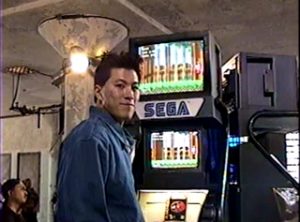
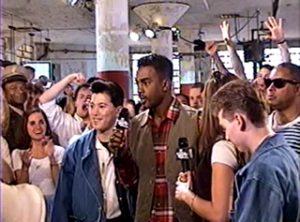
Recent Comments